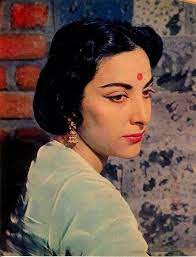Tracing legendary Indian actor Nargis Dutt's journey: Smooth sailing in turbulent waters!
- Sangeeta Saxena

- Jun 3, 2021
- 4 min read
Indian Cinema Column by Sangeeta Saxena

It is amazing that even after forty years of bidding goodbye to this mortal world, the journey of life of the famous, beautiful and respected actress of the golden era of Bollywood – Nargis- still is a story teller’s delight. The absorbing and intriguing story of the girl Fatima Rashid who blossomed into Nargis and then bloomed till the end as Mrs. Dutt, attracts the readers eyeballs even today.
This daughter of one of the earliest female film and music composer of the 1930s and early 40s Jaddanbai and Mohanchand Uttanchand Tyagi who converted to Islam and adopted the name Abdul Rashid, was launched as a lead actress by the top notch film maker of the time, Mehboob Khan in his 1943 blockbuster Taqdeer. For Fatima who had made her maiden appearance in the 1935 movie Talash-e- Haq as Baby Rani, it was not just a change in time and stature but also a change of identity, as Mehboob Khan gave her the screen name of Nargis. And the power and saleability of this name made her the most bankable female star from the late 40s to the early 60s.

But all the credit cannot be taken away by Mehboob Productions alone. If it gave Nargis Taqdeer, Humayun and Andaz in the 1940s, Wadia Movitone gave her Mela and RK Films Aag and Barsaat. The end of the decade also saw Nargis graduate from average to serious roles. And one factor which was stable in creating her popularity was music created by the great maestros Naushad, Ram Ganguli and Shankar Jaikishen and the voice of first Shamshad Begum and then Lata Mangeshkar.
The decade of 1950s began with Nargis in Jogan, Babul, continued with her in Deedar, Awara, Aah, Shri420, Chori Chori and ended with Mother India which fetched her the Karlovy Vary award for best actress.

It was also the decade which saw the unsurpassable on-screen chemistry between Raj Kapoor and Nargis which resulted into some great hits and some of the greatest melodies created for these films. This chemistry also resulted into a 9 years long relationship between the much married with children Raj Kapoor and Nargis. This ended when the patriarch of the Kapoor clan Prithviraj Kapoor did not permit a divorce and Nargis left the relationship to marry her Mother India co-star Sunil Dutt, who had saved her from a fire accident on the set during the shooting. And Nargis became Mrs. Dutt.

In a conscious decision to leave films to settle in domestic bliss Nargis wrapped up the films which were on the floor and her last film was Raat aur Din which fetched her the first National Award for Best Actress. Meanwhile Mr. & Mrs. Dutt had become parents to a son and two daughters. Sanjay Dutt, Namrata Dutt and Priya Dutt need no introduction.

The Dutts together formed the Ajanta Arts Cultural Troupe, which saw some of the famous singers and actors of the time getting associated to entertain soldiers in the remote borders . It was the first troupe to perform in Dhaka, after the liberation war of Bangladesh in 1971.
Nargis over the years developed a strong bond with differently abled children and became the first patron of the Spastics Society of India. She created a platform within and outside the film industry for this cause which got her recognition as a social worker and a Rajya Sabha nomination in 1980. In one of the sessions of the Parliament she got unwell and the check up in Mumbai confirmed pancreatic cancer. The family left no stone unturned . She was admitted in Memorial Sloan-Kettering Cancer Center in New York City for treatment, after which she returned to Mumbai and was admitted in Breach Candy Hospital where she breathed her last on 03 May 1981 after slipping into coma. A year after her death, the Nargis Dutt Memorial Cancer Foundation was established by her husband Sunil Dutt in her memory which has been funding and getting needy cancer patients treated.

And the journey of Fatima Rashid which started from 01 June 1929 in Calcutta now Kolkata, came to an end at the Badakabarastan in Marine Lines, Mumbai. But the nation did not forget this great actress who was a greater human being. A street in Bandra, Mumbai, is named Nargis Dutt Road in her memory. A postal stamp of face value 100 paise was issued by India Post was issued in Nargis' honour on 30 December 1993. The National Film Awards honoured her by instituting the Nargis Dutt Award for Best Feature Film on National Integration.
Nargis bloomed and spread fragrance like the flower she was named after. She left her fans and the Indian film industry with an eternal legacy for generations to come. She lives in her films and the repertoire of great melodies created for her. Today on her 92nd birthday we recall her as one who portrayed a perfect image of movie actresses and lived up to this expectation of the masses.
About the author:

Sangeeta Saxena is a journalist and film critic based in New Delhi, India. As a part of her decade long academic career she has also taught film criticism, film journalism, history of cinema both world and Indian, film review writing and music analysis. Her expertise spans from silent era to 1960s and has written many research papers for academic journals and media publications on various topics and issues pertaining to Bollywood since its inception to date. By profession Sangeeta Saxena is an aerospace and defence journalist and is the Editor cum Partner of the news portal Aviation & Defence Universe popularly called ADU.

















Comments